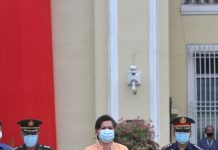With the city experiencing perennial flooding, the local government hopes to find modern ways to control the problem.
According to Engineer Andrew Lepardo operations head of the drainage maintenance section, they are currently making an inventory of the existing drainage system in the City.
If collated the data will be utilized through digital mapping where the drainage flow direction, existing outfall and drainage profile can be viewed in the map. Lepardo says the map can be done by using GPS or Global Positioning System and through profile surveying.
He admits that the current drainage lines are already 30 to 50 years old hence there is a need for a new comprehensive study that will come up with a new master plan for the city’s drainage.
One of the initial steps is the visit of a team from the Bureau of Designs- Department of Public Works and Highways central office to take a look at the initiative.
Another step taken to address to address the drainage problem is for new structures being built in Davao City to have drainage permits that the builders must secure before starting with the construction.
The drainage permit requirement is a drainage plan which includes a hydraulic computation that aims to measure the amount of water that the structure will divert to the drainage line.
In case they will determine that there is excessive water outflow, the Drainage Maintenance Section can recommend engineering interventions to minimize the load of water flowing to the existing drainage lines .
He also hopes that more green buildings will be built in the city. He cited SM-Lanang which uses green materials where instead of regular cement these so-called green materials allows rainwater to be absorbed to the ground because of their porous characteristics.
“For every 10 drops of rain, eight drops are absorbed to ground compared to regular cement which just deflects water.” Lepardo says.
Another feature in the still being constructed SM mall is the water holding tank which can keep the outflow of water for five to six hours rather than draining it immediately to the drainage lines. At least 50% of those collected in the holding tank are to be used in the comfort rooms and in the sky gardens. Also instead of gutters in the roof, the mall has sky gardens with plant boxes which absorb water rather than gutters that throw water out.
“Sadly dito lang sa Pilipinas hindi masyado known ang green buildings.” (Sadly here in the Philippines green buildings are not that well-known.) Lepardo lamented.
Aside from modern technology, Lepardo said that the key to having good drainage is to practice discipline particularly in throwing garbage properly. He said that about 60% of the materials extracted by drainage maintenance crews are considered as garbage and trash. [PIA 11/RG Alama]






